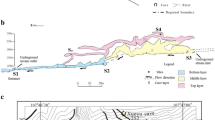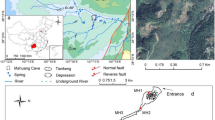Abstract
As a very important and active component of organic carbon, the role of dissolved organic carbon (DOC) in a karst dynamic system is worthy of in-depth investigation. Here, we investigated the parameters that affect DOC in the cave waters of Mahuang Cave (wild cave) and Dafeng Cave (show cave) in southwest China during a monitoring period spanning August 2020 to August 2021. Such analysis was conducted by continuously monitoring several environmental indices, including air temperature, precipitation, water temperature, DOC, dissolved inorganic carbon (DIC), pH, pCO2, electrical conductivity (EC), and anions and cations. Our results revealed that high levels of DOC in cave water appeared after a short dry period in late Autumn 2020 and May 2021. The variation of DOC concentration was mainly controlled by meteorological conditions and was strongly associated with water–rock–air interactions during the monitoring period. However, no significant connection was observed between variations in DOC concentration and caves. We conclude that DOC in cave water could be used as a paleoclimate proxy and that its relevance with karst carbon sink is considerable.
Research highlights
-
Seasonality of DOC variation is controlled by different factors.
-
Type of caves and waters exhibit little influence on variation of DOC concentrations.
-
In addition to meteorological factors, the influence of water-rock interaction on DOC is also significant.
-
DOC in cave water could be used as a paleoclimate proxy and its relevance with karst carbon sink is considerable.



Similar content being viewed by others
References
Amundson R, Stern L, Baisden T and Wang Y 1998 The isotopic composition of soil and soil-respired CO2; Geoderma 82 83–114.
Baker A, Smart P, Edwards R and Richard D 1993 Annual growth banding in a cave stalagmite; Nature 364 518–520.
Baker A, Barnes W and Smart P 1997 Variations in the discharge and organic matter content of stalagmite drip waters in Lower Cave, Bristol; Hydrol. Process. 11 1541–1555.
Ban F M, Pan G X, Zhu J, Cai B G and Tan M 2008 Temporal and spatial variations in the discharge and dissolved organic carbon of drip waters in Beijing Shihua Cave, China; Hydrol. Process. 22 3749–3758.
Berner R A 2003 The long-term carbon cycle, fossil fuels and atmospheric composition; Nature 426 323–326.
Bolan N S, Adriano D C, Kunhikrishnan A, James T, McDowell R and Senesi N 2011 Dissolved organic matter: Biogeochemistry, dynamics, and environmental significance in soils; Adv. Agron. 110 1–75.
Cao J H, Pan G X, Yuan D X and Jiang G H 2005 Seasonal changes of dissolved organic carbon in soil: Its environmental implication in karst area; Ecol. Environ. 14(2) 224–229.
Cao M, Jiang Y J, Chen Y, Fan J X and He Q F 2020 Variations of soil CO2 concentration and pCO2 in a cave stream on different time scales in subtropical climatic regime; Catena 185 1–15.
Cruz Jr F W, Karmann I, Magdaleno G B, Coichev N and Viana Jr O 2005 Influence of hydrological and climatic parameters on spatial-temporal variability of fluorescence intensity and DOC of karst percolation waters in the Santana Cave System, southeastern Brazil; J. Hydrol. 302 1–12.
Fairchild I J and Baker A 2012 Speleothem Science. From Process to Past Environment; Wiley-Blackwell, Oxford, 450p.
Genty D, Blamart D, Ouahd R and Gilmour M 2003 Precise dating of Dansgaard–Oeschger climate oscillations in western Europe from stalagmite data; Nature 421 833–837.
Hesterberg R and Siegenthaler U 1991 Production and stable isotopic composition of CO2 in a soil near Bern, Switzerland; Tellus B 43 197–205.
Hongve D 1999 Production of dissolved organic carbon in forested catchments; J. Hydrol. 224 91–99.
Kaiser K, Guggenberger G, Haumaier L and Zech W 2001 Seasonal variations in the chemical composition of dissolved organic matter in organic forest floor layer leachates of old-growth Scots pine (Pinus sylvestris L.) and European beech (Fagus sylvatica L.) stands in northeastern Bavaria, Germany; Biogeochemistry 55 103–143.
Lauritzen S E, Ford D C and Schwarcz H O 1986 Humic substances in a speleothem matrix-palaeoclimatic significance; Proceedings of the 9th International Conference of Speleology, pp. 77–79.
Li J Y and Li T Y 2018 Seasonal and annual changes in soil/cave air pCO2 and the δ13CDIC of cave drip water in response to changes in temperature and rainfall; Appl. Geochem. 93 94–101.
Mattey D P, Atkinson T C, Barker J A, Fisher R, Latin J P, Durrell R and Ainsworth M 2016 Carbon dioxide, ground air and carbon cycling in Gibraltar karst; Geochim. Cosmochim. Acta 184 88–113.
McDowell W H and Likens G E 1988 Origin, composition, and flux of dissolved organic carbon in the Hubbard Brook valley; Ecol. Monogr. 58 177–195.
McKnight D, Thurman E M, Wershaw R L and Hemond H 1985 Biochemistry of aquatic humic substances in Thoreau’s Bog, Concord, Massachusetts; Ecology 66(4) 1339–1352.
Mitchard E T A 2018 The tropical forest carbon cycle and climate change; Nature 559 527–534.
Moreno A, Stoll H, Jiménez-Sánchez M, Cacho I, Valero-Garcés B, Ito E and Edwards R L 2010 A speleothem record of glacial (25–11.6 kyr BP) rapid climatic changes from northern Iberian Peninsula; Global Planet. Change 71(3) 218–231.
Scott M J and Jones M N 1998 Concentrations and fluxes of dissolved organic carbon in drainage water from an upland peat system; Environ. Int. 24(5/6) 537–546.
Shopov Y Y, Ford D C and Schwarcz H P 1994 Fluorescent microbanding in speleothems: High resolution chronology and palaeoclimate; Geology 22 407–410.
Tegen I and Dorr H 1996 Mobilization of cesium in organic rich soils: Correlation with production of dissolved organic carbon; Water Air Soil Pollut. 88 133–144.
Tipping E, Woof C, Rigg E, Harrison A F, Ineson P, Taylor K, Benham D, Poskitt J, Rowland A P, Bol R and Harkness D D 1999 Climatic influences on the leaching of dissolved organic matter from upland UK moorland soils, investigated by a field manipulation experiment; Environ. Int. 25 83–95.
Toth V A 1998 Spatial and temporal variations in the dissolved organic carbon concentrations in the vadose karst waters of Marengo Cave, Indiana; J. Cave Karst Studies 60(3) 167–171.
van Beynen P, Bourbonniere R, Ford D and Schwarcz H 2001 Causes of colour and fluorescence in speleothems; Chem. Geol. 175 319–341.
Wang Y L, Zhou Z F, Xue B Q, Li P, Tian Z H, Zhang J and Tang Y T 2020 The vertical conversion characteristics and influence of the partial pressure of CO2 in the water-soil-atmosphere of critical karst zone; Acta Geogr. Sinica 75(5) 1008–1021.
White W B and Brennan E S 1989 Luminescence of speleothems due to fulvic acid and other activators; Proceedings of the 10th International Congress of Speleology, pp. 212–214.
Xie X N, Wang S J, Zhou Y C and Luo W J 2008 Three-dimensional fluorescence spectral characteristics of dissolved organic carbon in cave drip waters and their responses to environment changes: Four cave systems as an example in Guizhou Province, China; Chinese Sci. Bull. 53(6) 884–889.
Acknowledgements
This research was financially supported by the National Natural Science Foundation of China (Grant no. 42161048), the Science and Technology Foundation of Guizhou Province (QKHJC-ZK [2021]-191, QKHJC [2020] 1Y154), and the Guizhou Province’s high-level innovative talent training plan ‘hundred’ level talents (Qiankehe platform talents [2016] 5674).
Author information
Authors and Affiliations
Contributions
HD defined the objectives of the study and prepared the manuscript with contributions from all the co-authors. YX, LS, and SD did the fieldwork. HZ and JH analyzed samples and supported the visualization of data. ZZ and LY supervised the entire research and reviewed the first draft and provided advice for improvement. All authors agree with this submission and the publication of this article.
Corresponding author
Additional information
Communicated by Abhijit Mukherjee
Corresponding editor: Abhijit Mukherjee
Rights and permissions
About this article
Cite this article
Dong, H., Zhou, Z., Yan, L. et al. Dynamic variation of dissolved organic carbon in karst cave waters in a subtropical climatic regime. J Earth Syst Sci 132, 132 (2023). https://doi.org/10.1007/s12040-023-02148-4
Received:
Revised:
Accepted:
Published:
DOI: https://doi.org/10.1007/s12040-023-02148-4




